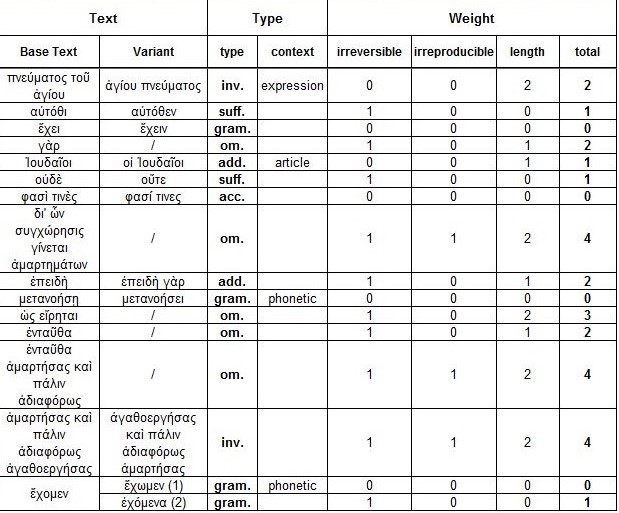The Lachmannian/Maas method is based on the concept of error. As Trovato (2014, 56) puts it, "only important monogenetic errors should be used as indicative errors to reconstruct a genealogy of the copies known to us". Maas was the first to call errors which can be used to make stemmatic inferences Leitfehler or errores significativi (‘indicative/significant errors’). He formulates this as "zu stemmatischen Folgerungen verwendbare Fehler" ("errors that may be used to reach conclusions about the stemma"; p. 26). Significant errors encompass both separative errors (errores separativi, Trennfehler) and conjunctive errors (errores conjunctivi, Bindefehler).
In practice, it is difficult to assess which readings are significant, or as Salemans puts it, "relationship-revealing" (Salemans 2000, passim), and this difficulty has been noted by many scholars. Roughly speaking, a significant error is an error that cannot be easily produced independently by several copyists (polygenesis), and cannot be corrected easily, in other words a good significant error will be irreversible and not reproducible. It is not easy to determine a priori which types of variant readings will indeed satisfy to those two criteria, and some scholars have suggested that the character of being significant or not is not something absolute, but rather something that is more or less likely. This is why some have tried to "weight" variant readings: Macé/Sanspeur 2000, Spencer et al. 2004, Macé/De Vos/Geuten 2012, etc. There have been as well some attempts at automating partly the procedures to measure the significance of variants (see Roelli/Bachmann 2010, Camps/Canfiero 2015), but at any event the evaluation of the variant readings will remain largely a philological task.
Illustration
Fig. 1. Macé, De Vos, and Geutens 2012, 114 (Figure 2)
References
– Camps, Jean-Baptiste, and Florian Cafiero. 2015. “Genealogical Variant Locations and Simplified Stemma: a Test Case.” In: Tara Andrews and Caroline Macé (eds.), Methods and means for digital analysis of classical and medieval texts and manuscripts. Turnhout: Brepols Publishers, 69-93.
– Maas, Paul. 1960. Textkritik. 4th ed. Leipzig: Teubner. – 1st ed. 1927.
– Macé, Caroline, and Clotaire Sanspeur. 2000. “Nouvelles perspectives pour l'histoire du texte des Discours de Grégoire de Nazianze. Le cas du Discours 6 en grec et en arménien.” Le Muséon 113: 377-416.
– Macé, Caroline, Ilse De Vos, and Koen Geuten. 2012. “Comparison of stemmatological and phylogenetic methods to understand the copying history if the Florilegium Coislinianum.” In: Alessandra Bucossi and Erika Kihlman (eds.). Ars edendi lectures Series, vol. II. Stockholm: Stockholm University Press, 107-129.
– Roelli, Philipp, and Dieter Bachmann. 2010. “Towards Generating a Stemma of Complicated Manuscript Traditions: Petrus Alfonsi’s Dialogus.” Revue d’histoire des textes N.S. 5: 307–321.
– Salemans, Ben J.P. 2000. Building Stemmas with the Computer in a Cladistic, Neo-Lachmannian, Way. The Case of Fourteen Text Versions of Lanseloet van Denemerken (PhD). Nijmegen: Nijmegen University Press. http://www.dbnl.org/arch/sale003buil01_01/pag/sale003buil01_01.pdf
– Spencer, Matthew, Line R. Mooney, Aidan C. Barbrook, Barbara Bordalejo, Christopher J. Howe, and Peter Robinson. 2004. “The Effects of Weighting Kinds of Variants.” In: Reenen, Pieter van - August den Hollander - Margot van Mulken (eds.). Studies in stemmatology II. Amsterdam - Philadelphia: John Benjamins Publishers, 227-240.
– Trovato, Paolo. 2014. Everything You Always Wanted to Know about Lachmann’s Method: A Non-Standard Handbook of Genealogical Textual Criticism in the Age of Post-Structuralism, Cladistics, and Copy-Text. Foreword by Michael D. Reeve. Firenze: Libreriauniversitaria.it edizioni.
In other languages
DE: Leitfehler
FR: erreur significative
IT: errore guida / significativo
CM, MH

